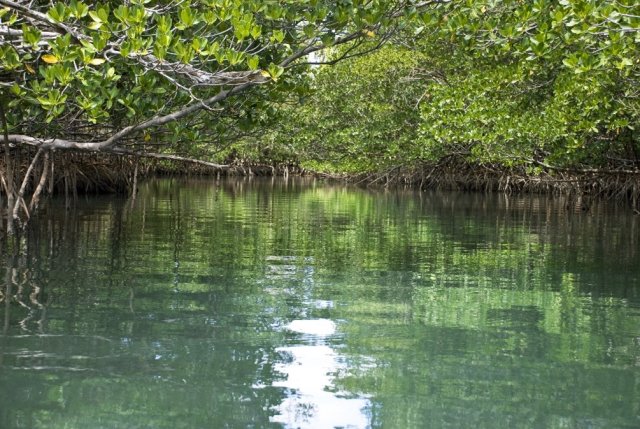Mapping Moving Mangroves
Published June 11, 2024

If you ever explore the marshy coasts of Florida, Texas, or Louisiana, you may see trees with slender roots that arc into the water. These resilient trees are part of a network called mangrove forests, a collection of several species of trees that thrive in salty environments. Mangrove forests provide a number of ecosystem benefits such as preventing coastal erosion, reducing storm surges, and supporting habitats for endangered species such as manatees.
Mangroves are also powerful carbon sinks. Carbon sinks are natural environments recognized for their ability to absorb carbon dioxide. With the ability to sequester carbon at an annual rate ten times greater than tropical forests, mangrove forests are invaluable to their ecosystems, storing billions of tons of carbon in their soil. Mangroves are successful at storing carbon for a couple of reasons: the trees grow plentifully throughout the year, storing carbon as they expand; and their soil is often underwater and deprived of oxygen, causing it to decompose more slowly and trap carbon for longer periods of time. Ensuring the wellbeing of mangroves and their ecosystems is an important step to removing greenhouse gases as the trees can take carbon out of the atmosphere and keep it underground. The preservation of these coastal protectors is increasingly recognized as a nature-based way of combating climate change.
Several factors, both caused by humans (anthropogenic) and natural, are changing mangrove ecosystems worldwide. In the contiguous United States, some of these factors include urbanization, climate change, coastal development, sea level rise and natural disasters. To complicate matters, several of these factors can compound the changes occurring in mangrove ecosystems. For instance, coastal development can interrupt these ecosystems and make them less resilient to natural disasters, which may be strengthened by climate change. The complexity of these intertwined factors calls for extensive research into understanding the changes in mangrove forests.
EPA researcher Dr. Chandra Giri has dedicated years to studying the changes affecting mangrove ecosystems. Well-known for his work that produced the first and most comprehensive mangrove forest database of the world, Giri has built a reputation as a detailed researcher. One of his recent publications focuses on mangroves within the contiguous United States and spans a 40-year period. Using land satellite data and image processing techniques, Giri analyzed the dynamics of mangrove forests in Florida, Texas, and Louisiana every five years from 1980 to 2020. Analyzing mangrove growth over a long period of time helps to prevent skewed data that could occur from comparing growth over just a handful of years.
The results of Giri’s research show that mangrove coverage in the contiguous United States has expanded by 13.5% in the last 40 years. Results show that mangrove forests are expanding inland, but a northward expansion is uncertain. Several factors could have contributed to this inland migration, including winter freezes, storms, land-use practices, erosion, impoundment (man-made structures that raise the water above its natural level), sea level rise, and forest restoration efforts. The influence of these factors is also dependent on the geographic location of the mangroves. Some mangroves that were subjected to hurricanes, for instance, suffered from uprooting, leaf detachment, and trunk fractures. Other mangroves underwent significant damage from winter freezes.
Despite these disturbances, the forests not only endured but rebounded with remarkable effectiveness. They recuperated so well that some managed to surpass 90% of their initial levels within just a few years, showing nature’s remarkable ability to regenerate and thrive even in challenging circumstances.
The vital role mangroves play in carbon sequestration not only makes them significant in efforts to curb climate change, but also in efforts to maintain ecosystem stability. Continuing to monitor changes in mangrove forest covers is important to understand how factors such as urbanization, climate change, coastal development, sea level rise, and natural disasters affect the trees. Giri’s extensive research highlights the importance of understanding how mangrove ecosystems are changing, especially in the face of anthropogenic and natural factors.
Learn More About the Science
